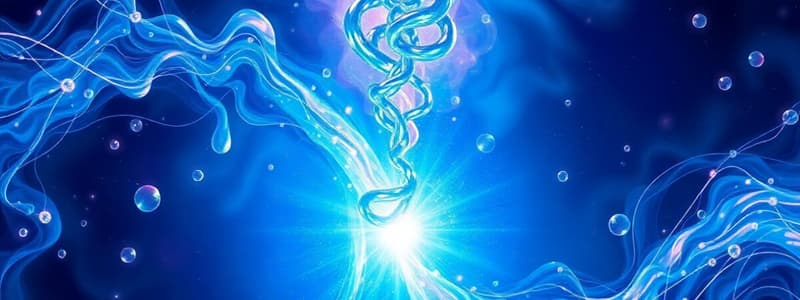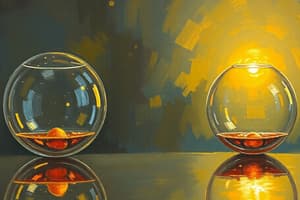Podcast
Questions and Answers
A reaction is said to be reversible if the products can react to form the reactants again. Which of the following is a feature of a reversible reaction?
A reaction is said to be reversible if the products can react to form the reactants again. Which of the following is a feature of a reversible reaction?
- It proceeds to completion.
- It can be reversed only under very specific conditions.
- It is not affected by changes in temperature.
- It can be easily reversed. (correct)
In a reversible reaction, what does the double half-headed arrow (⇌) represent?
In a reversible reaction, what does the double half-headed arrow (⇌) represent?
- The reaction is at equilibrium.
- The reaction moves in forward direction only.
- The reaction is irreversible.
- The reaction can move in both forward and reverse directions. (correct)
What is the difference between a reversible reaction and an irreversible reaction?
What is the difference between a reversible reaction and an irreversible reaction?
- A reversible reaction is always exothermic, while an irreversible reaction is always endothermic.
- A reversible reaction proceeds to completion while an irreversible reaction does not.
- A reversible reaction involves the formation of a new substance, while an irreversible reaction does not.
- A reversible reaction can be reversed, while an irreversible reaction cannot be reversed. (correct)
Which of the following is an example of an irreversible reaction?
Which of the following is an example of an irreversible reaction?
What is dynamic equilibrium in a reversible reaction?
What is dynamic equilibrium in a reversible reaction?
What is the volume occupied by one mole of a gas at standard temperature and pressure (STP)?
What is the volume occupied by one mole of a gas at standard temperature and pressure (STP)?
In the chemical reaction below, what is the product? $3H_{2}(g) + N_{2}(g)
ightarrow 2NH_{3}(g)$
In the chemical reaction below, what is the product? $3H_{2}(g) + N_{2}(g) ightarrow 2NH_{3}(g)$
In a reversible reaction, what happens when the concentration of reactants is increased?
In a reversible reaction, what happens when the concentration of reactants is increased?
Flashcards
Reversible Reaction
Reversible Reaction
A reaction where products can revert to reactants.
Irreversible Reaction
Irreversible Reaction
A reaction where products cannot revert to reactants.
Dynamic Equilibrium
Dynamic Equilibrium
State where forward and reverse reactions occur at the same rate.
Reactants
Reactants
Signup and view all the flashcards
Products
Products
Signup and view all the flashcards
Single Arrow in Reactions
Single Arrow in Reactions
Signup and view all the flashcards
Double Arrow in Reactions
Double Arrow in Reactions
Signup and view all the flashcards
Example of Dynamic Equilibrium
Example of Dynamic Equilibrium
Signup and view all the flashcards
Study Notes
Reversible Reactions and Dynamic Equilibrium
- A chemical reaction involves reactants forming products
- Reactants are the substances that combine
- Products are the formed substances
- Example: Hydrogen and Nitrogen form Ammonia
- 3H₂(g) + N₂(g) → 2NH₃(g)
Irreversible Reactions
- Products do not recombine to form the original reactants
- Once complete, the reaction stops
- Example: Magnesium reacting with excess hydrochloric acid
- Mg(s) + HCl(aq) → MgCl₂(aq) + H₂(g)
Reversible Reactions
- Products can react to reform original reactants
- Reactions never reach completion
- Represented by a double half-headed arrow
- Example: Heating mercury oxide
- 2HgO(s) ⇌ 2Hg(l) + O₂(g)
- Forward and reverse reactions occur continuously
- Equilibrium is achieved when the rates are equal
Equilibrium
- When the forward and reverse reactions occur at the same rate
- The concentrations of reactants and products remain constant
- Example: Mercury and Oxygen form Mercury Oxide
- The rates of the forward and reverse reactions are equal at equilibrium
Studying That Suits You
Use AI to generate personalized quizzes and flashcards to suit your learning preferences.




